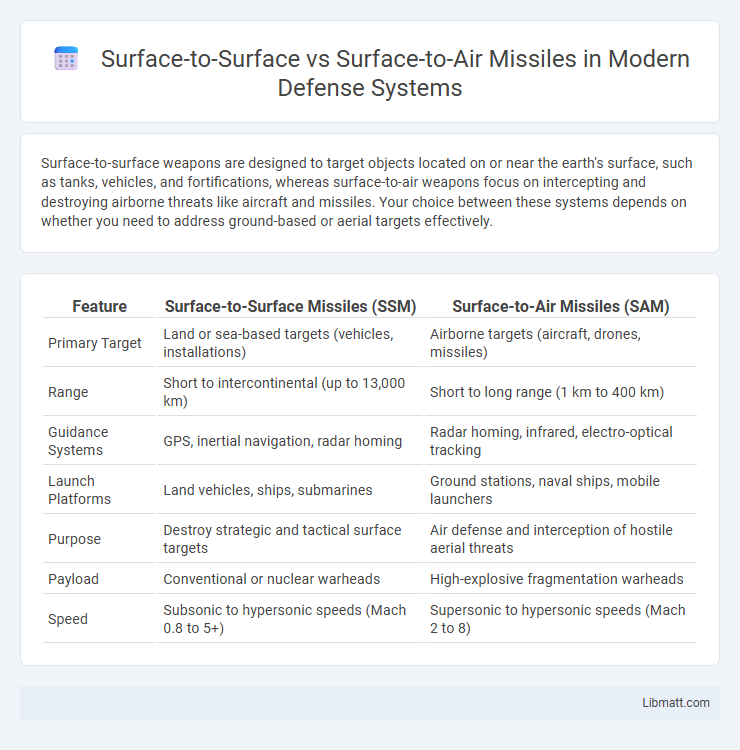Surface-to-surface weapons are designed to target objects located on or near the earth's surface, such as tanks, vehicles, and fortifications, whereas surface-to-air weapons focus on intercepting and destroying airborne threats like aircraft and missiles. Your choice between these systems depends on whether you need to address ground-based or aerial targets effectively.
Table of Comparison
| Feature | Surface-to-Surface Missiles (SSM) | Surface-to-Air Missiles (SAM) |
|---|---|---|
| Primary Target | Land or sea-based targets (vehicles, installations) | Airborne targets (aircraft, drones, missiles) |
| Range | Short to intercontinental (up to 13,000 km) | Short to long range (1 km to 400 km) |
| Guidance Systems | GPS, inertial navigation, radar homing | Radar homing, infrared, electro-optical tracking |
| Launch Platforms | Land vehicles, ships, submarines | Ground stations, naval ships, mobile launchers |
| Purpose | Destroy strategic and tactical surface targets | Air defense and interception of hostile aerial threats |
| Payload | Conventional or nuclear warheads | High-explosive fragmentation warheads |
| Speed | Subsonic to hypersonic speeds (Mach 0.8 to 5+) | Supersonic to hypersonic speeds (Mach 2 to 8) |
Introduction to Surface-to-Surface and Surface-to-Air Missiles
Surface-to-surface missiles (SSMs) are designed to strike ground targets from one surface location to another, utilizing various propulsion systems such as solid, liquid, or hybrid fuels for precise targeting at short to long ranges. Surface-to-air missiles (SAMs) are engineered to detect, track, and destroy airborne threats like aircraft, drones, and other missiles, employing radar guidance and infrared homing technologies to intercept targets at varying altitudes. Both missile types play critical roles in modern military strategy, with SSMs emphasizing offensive ground strikes and SAMs providing defensive airspace protection.
Key Differences Between Surface-to-Surface and Surface-to-Air Missiles
Surface-to-surface missiles are designed to strike ground targets from one land position to another, while surface-to-air missiles target airborne threats such as aircraft or drones from the ground. Key differences include guidance systems, with surface-to-surface often using GPS or inertial navigation for long-range precision strikes, whereas surface-to-air missiles rely on radar or infrared homing to track fast-moving targets. Your defense strategy must consider these distinctions to optimize missile deployment for specific operational needs.
Technological Advancements in Missile Systems
Surface-to-surface missile systems have seen significant technological advancements in propulsion, accuracy, and payload capacity, enabling extended ranges and enhanced precision targeting through GPS and inertial navigation systems. Surface-to-air missile systems incorporate advanced radar guidance, infrared homing, and electronic countermeasures to improve interception success against fast, maneuvering aerial threats including drones and stealth aircraft. Integration of artificial intelligence and network-centric warfare capabilities further enhances both missile types, allowing real-time target data sharing and adaptive response to dynamic battlefield conditions.
Guidance and Targeting Mechanisms
Surface-to-surface missiles use inertial guidance combined with GPS or terrain contour matching for precise targeting of fixed or mobile ground targets. Surface-to-air missiles rely heavily on radar, infrared, and electro-optical seekers to detect and track fast-moving aerial threats, ensuring accurate interception. Your selection between these missile types should consider the specific guidance systems best suited for the target environment and mission objectives.
Deployment Platforms and Launch Methods
Surface-to-surface missiles are typically deployed from land-based vehicles, naval ships, and submarines, using launch platforms such as mobile launchers, fixed silos, or submarine tubes to achieve strategic and tactical strikes against ground targets. Surface-to-air missiles are launched from ground-based radar-guided launchers, naval vessels, or aircraft, designed for rapid response and interception of airborne threats, often utilizing vertical launch systems or truck-mounted platforms for mobility and flexibility. The choice of deployment platform and launch method critically influences the missile's range, accuracy, and adaptability to mission requirements in both surface-to-surface and surface-to-air roles.
Operational Uses in Modern Warfare
Surface-to-surface missiles are primarily utilized for striking land targets with precision over varying distances, often deployed to neutralize enemy infrastructure, armored units, and strategic installations. Surface-to-air missiles serve as critical components of air defense systems, designed to detect, track, and intercept hostile aircraft and incoming missiles to protect ground forces and key assets. Modern warfare integrates these missile systems with advanced targeting technologies and networked command systems to enhance battlefield situational awareness and operational effectiveness.
Defense Strategies Against Missile Threats
Surface-to-surface missile defense strategies emphasize early detection, trajectory analysis, and point-defense systems to intercept incoming projectiles before impact on critical ground assets. Surface-to-air defense focuses on detecting and destroying aerial threats, including missiles launched from aircraft or drones, using radar-guided interceptor missiles and advanced anti-aircraft artillery. Integrated defense networks combine sensor fusion, electronic warfare, and layered missile defense systems to enhance protection against diverse missile threats from both surface and air platforms.
Global Leaders in Missile Development
Global leaders in missile development such as the United States, Russia, China, and Israel excel in both surface-to-surface and surface-to-air missile technologies, tailoring advanced systems to meet diverse defense needs. Surface-to-surface missiles typically focus on long-range precision strikes against ground targets, while surface-to-air missiles prioritize intercepting and neutralizing airborne threats with high-speed tracking and engagement capabilities. Your defense strategy can benefit from understanding these countries' innovations, including the U.S. Patriot missile system and Russia's S-400, which represent cutting-edge surface-to-air defense, alongside ballistic and cruise missile advancements for surface-to-surface roles.
Recent Innovations and Future Trends
Recent innovations in surface-to-surface missile technology emphasize increased precision guidance systems and hypersonic capabilities, significantly enhancing strike accuracy and speed. Surface-to-air defense systems are evolving with advanced radar networks and integrated multi-layered interception techniques to counter diverse aerial threats, including drones and stealth aircraft. Future trends indicate a convergence of AI-driven targeting algorithms and network-centric warfare capabilities to improve real-time threat detection and engagement efficiency in both domains.
Conclusion and Strategic Implications
Surface-to-surface missile systems offer direct targeting and are ideal for engaging ground-based threats with precision, while surface-to-air systems specialize in intercepting aerial threats, enhancing air defense capabilities. Your strategic assets must balance investment in both to ensure comprehensive defense against multifaceted threats. Prioritizing integration of these systems boosts operational flexibility and deters adversaries across diverse combat scenarios.
surface-to-surface vs surface-to-air Infographic

 libmatt.com
libmatt.com